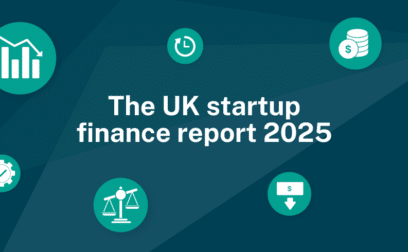Getting a young company off the ground has never been easy. As well as assembling a team, finding premises, and building the concept, there’s the mammoth task of securing funds. Investors are notoriously wary of entrepreneurs and untested ideas, which is partly why approximately 29% of UK startups fail in their first year. The government’s SEIS and EIS investment programmes are designed to solve this difficult problem. Both schemes offer investors generous tax breaks to invest in new businesses. They invest, you get the funding, they get a tax break. It’s an immensely successful idea, with more than £23 billion raised for more than forty thousand companies since 1993.
What does SEIS stand for?
Seed Enterprise Investment Scheme.
What does EIS stand for?
Enterprise Investment Scheme.
Are SEIS and EIS the same thing?
No. Although both schemes aim to draw investment into high-growth potential, smaller and younger UK companies, there are significant differences between the programmes. Additionally, entrepreneurs and investors should understand that neither SEIS nor EIS are a source of venture capital. They are incentives. The government does not provide cash in either programme. Instead, SEIS and EIS provide tax relief to investors who buy shares in qualifying businesses. This should make it easier for those companies to attract the investment they need.
The key difference between SEIS and EIS is that SEIS is explicitly targeted at startups and early-stage businesses, whereas EIS can be used by larger companies.
- Seed Enterprise Investment Scheme: SEIS targets investment for early-stage companies – those with less than three years trading history and 25 employees. Individual investors (no companies) can invest up to £200,000 in an SEIS business per tax year. SEIS companies can accept no more than £250,000 SEIS funding total
- Enterprise Investment Scheme: EIS supports larger and more established businesses – those with up to seven years trading history and 250 employees. Individual or corporate investors can invest up to £1 million per tax year. The company can accept up to £5 million per tax year and no more than £12 million EIS funding total. Corporate investors in EIS do not receive tax relief on their investment.
EIS has different criteria for Knowledge Intensive Companies (KIC) – which are typically those with high research/development costs and requirements. These companies can accept EIS funding within ten years of trading and may have up to 500 employees. They can also accept up to £10 million per tax year and up to £20 million EIS funding total.
| Key differences between SEIS and EIS venture capital investment programmes | ||
| SEIS | EIS | |
| Company location | UK | UK |
| Maximum trading age of business | 3 years | 7 years or 10 years for KIC |
| Maximum number of employees | 25 | 250 or 500 for KIC |
| Maximum gross assets | £200,000 | £15m |
| Maximum investment allowed | £250,000 | £12m or £20m for KIC |
| Corporate investors allowed | No | Yes, but no tax relief |
| Funds must be spent within | 3 years | 2 years |
| Initial tax relief rate | 50% | 30% |
| Capital Gains Tax relief | Yes | Yes |
| Loss relief | Yes | Yes |
Still unsure which to go for? Register with Swoop to help decide which scheme is best for your business.
Note: from April 1st 2023 the amount a business can receive in SEIS funding rose to £250,000, the amount an investor can contribute rose to £200,000, and the maximum age of the business able to take advantage of the scheme increased from 2 years to 3 years.
SEIS and EIS eligibility
Businesses wishing to participate in SEIS or EIS must meet the following criteria –
SEIS:
- Be new or trading for less than three years
- Be a qualifying trade or business
- Be established in the UK
- Not trading on a recognised stock exchange at the time of the share issue
- Not be preparing to become a quoted company or a subsidiary of one at the time of the share issue
- Not be in control of another company unless that company is a qualifying subsidiary
- Not be controlled by another company since incorporation
- Not have gross assets over £200,000 when the shares are issued
- Not be a member of a partnership
- Have less than 25 full-time equivalent employees in total when the shares are issued.
EIS:
- Be new or trading for less than seven years, (ten for KIC)
- Be a qualifying trade or business
- Be established in the UK
- Not trading on a recognised stock exchange at the time of the share issue
- Not be preparing to become a quoted company or a subsidiary of one at the time of the share issue
- Not be in control of another company unless that company is a qualifying subsidiary
- Not be controlled by another company or does not have more than 50% of its shares controlled by another company
- Not have gross assets over £15 million when the shares are issued
- Have less than 250 full-time equivalent employees in total when the shares are issued (500 employees for KIC).
Note: businesses that have already received investment through the Enterprise Investment Scheme (EIS) or from a venture capital trust, cannot use SEIS.
How much can my business raise?
To qualify for tax relief, there are maximum investments companies can accept in SEIS or EIS:
- SEIS – up to £250,000 total
- EIS – £5 million in one year and up to £12 million total, or £20 million for KIC
How much can an investor invest?
Investors can invest different sums within each scheme –
SEIS:
- Up to £200,000 per tax year
- Individual investors only – no corporations
- SEIS companies can accept no more than £250,000 SEIS funding total
EIS:
- Up to £1 million per tax year, or £2 million for KIC
- Individual and corporate investors okay. Corporations do not get tax relief on investment
- EIS Companies can accept no more than £12 million in EIS funding total, (£20 million for KIC).
Note: from April 2023 the amount a business can receive in SEIS funding rose to £250,000, the amount an investor can contribute rose to £200,000, and the maximum age of the business able to take advantage of the scheme rose from 2 years to 3 years.
What can the funds be used for?
SEIS and EIS have rules for the use of raised funds:
- SEIS – funds must be spent within three years of investment
- EIS – funds must be spent within two years of investment
Funds must be spent on either:
- A qualifying trade
- Preparing to carry out a qualifying trade
- Research and development that’s expected to lead to a qualifying trade
SEIS investments cannot be used to buy shares, unless the shares are in a qualifying 90% subsidiary that uses the money for a qualifying business activity. EIS investments cannot be used to buy shares in any company.
What is Advance Assurance (AA) for SEIS/EIS?
Investors seeking to invest in SEIS and EIS need to know the company they are investing in is eligible for the appropriate scheme. If it’s not, they will not get their tax breaks. Businesses can obtain proof of their eligibility for SEIS or EIS by seeking Advance Assurance from HMRC. (Advance Assurance will not tell the company if an investor is eligible for either investment scheme).
Applications for AA can be filed by the company secretary, a director, or a trustee if it the social enterprise is a charitable trust. They will need to provide details of potential investors as well as the following:
- Forecast of how much money you hope to raise
- Business plan and financial forecasts
- A copy of the latest accounts if available
- List of which companies will use the investments
- Details of all trading and activities to be carried out, plus an estimate of how much you expect to spend on each activity
- A list of any amounts, dates, and venture capital schemes under which you’ve previously received an investment
- Up-to-date copy of the memorandum and articles of association and details of any changes you expect to make
- A copy of the register of members from the date you apply for Advance Assurance
- Latest draft of any documents you use to explain your proposal to potential investors (your ‘pitch deck’)
- Details of any other agreements between the company and the shareholders or VCT
- A signed letter from one of your directors or trustees if you’re allowing an agent to act on your behalf
- A completed checklist for SEIS or EIS with your Advance Assurance application form
- Any other documents to show you meet the qualifying conditions for the scheme
HMRC will contact the applicant after they have made their decision. If their answer is positive, they will provide a statement that says the investment is likely to qualify for SEIS or EIS. This can be shown to potential investors. Note the word ‘likely’ in HMRC’s statement. It is an indication of eligibility, not a cast-iron guarantee. If HMRC declines to offer SEIS or EIS, they will usually say why.
The adjudication process can take up to eight weeks.
Read more: our in-depth Advance Assurance (AA) guide.
How can I follow up with HMRC on my AA application?
To discuss an ongoing AA application, you can email HMRC at: enterprise.centre@hmrc.gov.uk although it may take up to two weeks to get a reply.
You can also phone HMRC on 0300 123 3440. However, this is not a direct line, it is a messaging service. You can leave a message and HMRC will determine if a reply is needed. You will usually get an answer quicker by email than by calling.
Lastly, you can write to HMRC at:
Venture Capital Reliefs Team
HM Revenue and Customs
WMBC
BX9 1BN
Can I raise SEIS and EIS funding at the same time?
Yes and no. A business seeking investment using both the SEIS and EIS programmes needs to raise their initial investment using SEIS first, before moving on to EIS (assuming all the eligibility and qualifying conditions are met). You cannot raise your first funds in EIS and then go back to SEIS for a second round.
This means it is possible to apply for SEIS and EIS at the same time. Once your company passes the £250,000 SEIS limit, you can raise additional funds of up to £5 million or more using EIS. This method will make share allocation a little more complicated. Investors would usually be allocated SEIS shares on a first come, first served basis, then remaining investors would be offered EIS shares after the initial SEIS limit is reached. In some cases, investors may wish to subscribe for shares in both the SEIS and EIS categories.
Companies raising finance this way must ensure that they do so within the guidelines. HMRC rules state that investments cannot be raised under the SEIS and EIS on the same day and that the investments must be raised as SEIS first and then EIS. Additionally, EIS investments must always be raised at least one day after any SEIS investments.
Importantly, no SEIS or EIS shares can be issued until after they have been fully paid-up for. This means your company must be able to accept payment before any shares are issued.
Which scheme is best for my business?
This depends on your company’s circumstances and your funding needs. Clearly, if your business is outside the eligibility criteria of SEIS – for example it is older than three years or with more than 25 employees – you must go the EIS route. Alternatively, if your company qualifies for SEIS, but you need more than £250,000, you could first go with SEIS and then with EIS. (Pursuing both schemes at the same time – see FAQ above).
To decide which scheme is best for your business, answer these questions:
- Do you meet the SEIS criteria and need up to £250,000? If yes, then SEIS
- Do you meet the SEIS and EIS criteria and need more than £250,000? If yes, then either EIS, or SEIS first, then EIS
- Do you not meet the SEIS criteria, but are eligible for EIS? If yes, then EIS
How do I apply/claim SEIS or EIS?
Meeting the requirements of SEIS or EIS to make your company most attractive to investors can be tricky. Small mistakes can have big consequences. Businesses seeking to raise funds via either investment scheme should engage a professional service to guide them through the process.
Register with Swoop to discuss either of these schemes and the many other options for raising capital for your new business.
Swoop requires writers to use primary sources to support their work. These include white papers, government data, original reporting, and interviews with industry experts. We also reference original research from other reputable publishers where appropriate.
Swoop requires writers to use primary sources to support their work. These include white papers, government data, original reporting, and interviews with industry experts. We also reference original research from other reputable publishers where appropriate.
UK startup statistics: https://www.cbinsights.com/research/startup-failure-reasons-top/
EIS : https://www.gov.uk/guidance/venture-capital-schemes-apply-for-the-enterprise-investment-scheme
Advance ssurance: https://www.gov.uk/guidance/venture-capital-schemes-apply-for-advance-assurance
Qualifying trades: https://www.gov.uk/guidance/venture-capital-schemes-raise-money-by-offering-tax-reliefs-to-investors#trades
Qualifying subsidiary: https://www.gov.uk/guidance/venture-capital-schemes-apply-for-the-enterprise-investment-scheme#subsidiary
HMRC rules: https://www.gov.uk/hmrc-internal-manuals/venture-capital-schemes-manual/vcm8030



































 yet? Register here!
yet? Register here!